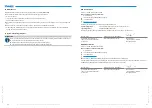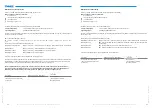
INSTALLATION AND OPERATING INSTRUCTIONS:
GEH6000IL/GED6000IL
INSTALLATION AND OPERATING INSTRUCTIONS:
GEH6000IL/GED6000IL
36
37
EN / 2021-07-28
DDOC00212 / 0
EN / 2021-07-22
DDOC00212 / 0
Zimmer GmbH
•
Am Glockenloch 2
•
77866 Rheinau, Germany
•
+49 7844 9138 0
•
www.zimmer-group.com
Zimmer GmbH
•
Am Glockenloch 2
•
77866 Rheinau, Germany
•
+49 7844 9138 0
•
www.zimmer-group.com
11.13.3.1
Group 60 Force profiles – outside gripping
In movement profile group 60, the product moves in the ForceProfile
from the BasePosition toward the WorkPosition onto the workpiece using
the ControlWord command 0x0200.
When the workpiece is gripped, the configured gripping force is built up
and the product goes into a self-locked state. For releasing, an internal
unlocking operation must be carried out.
If no workpiece is gripped during the gripping process, a movement to
WorkPosition is carried out and braking starts at this position. As a result,
the product moves slightly behind the configured position before it turns
around and comes to a stop at the WorkPosition. This enables secure
gripping of workpieces up to the WorkPosition.
For opening, the ControlWord command 0x0100 is written. Then the
product moves away from the workpiece to the BasePosition in the Positi-
onProfile without the need for any prompts from the operator. Here, the
product moves at the speed set in the DriveVelocity parameter.
The individually available DeviceModes and their differences are
explained in the following.
60– Force profile – without holding pressure for energy-saving gripping
When starting from the BasePosition, an unlocking operation is run for releasing. Only then does the product start moving
toward the workpiece. If the product encounters the workpiece while moving, an increase in current is detected and the
configured gripping force is built up. The product is now in the self-locked state and the motor is practically de-energized.
If the workpiece disengages from the gripper, the gripper jaws do not follow along and no part loss can be detected.
Ö
Because in this mode the motor current is switched off after gripping the workpiece, this mode provides outstanding
energy savings during gripping.
61– Force profile – high clock rate for energy-saving gripping
Behaves like mode 60, but when the gripping movement starts, the unlocking operation is omitted. This starts the
movement immediately and enables a shorter response time in the gripping direction towards the WorkPosition. It must be
ensured that in the BasePosition, no external forces act on the gripper jaws.
63 – Force profile – with holding pressure for detecting part loss – standard
Behaves like mode 60, but in addition, in this mode the motor is energized continuously after gripping the workpiece, which
results in further movement to the WorkPosition when parts are lost. This enables the part loss to be detected by sensing
the WorkPosition, otherwise the TeachPosition bit is TRUE.
Ö
This mode is the
recommended standard operating mode
!
65 – Force profile – without holding pressure for flexible/elastic components
Behaves like mode 60, but the product has a lower movement speed because the majority of the gripping force is created
directly by the motor current. However, it is no longer possible to generate the full nominal force because of the lower
kinetic energy. Therefore, this movement profile is better suited for flexible/elastic workpieces. The gripping force generated
in these movement profiles depends on the elasticity of the workpiece.
Group 60 – Outside gripping
DeviceMode
Action
ControlWord
6x
Move toward the BasePosition for opening the product.
0x0100
60
Move toward the WorkPosition until this position or the workpiece is reached and
switch off the motor.
0x0200
61
Move toward the WorkPosition without an unlocking process until this position or
the workpiece is reached.
0x0200
go
Move toward the WorkPosition until this position or the workpiece is reached and
detect part loss.
0x0200
65
Move toward the WorkPosition until this position or the workpiece is reached.
Mode for elastic/flexible components.
0x0200
11.13.3.2
Group 70 Force profiles – inside gripping
In movement profile group 70, the product in the ForceProfile moves
from the WorkPosition toward the BasePosition onto the workpiece using
the ControlWord command 0x0100.
When the workpiece is gripped, the configured gripping force is built up
and the product goes into a self-locked state. For releasing, an internal
unlocking operation must be carried out.
If no workpiece is gripped during the gripping process, a movement to
BasePosition takes place and braking starts at this position. As a result,
the product moves slightly behind the configured position before it turns
around and comes to a stop at the BasePosition. This enables secure
gripping of workpieces up to the BasePosition.
For opening, ControlWord command 0x0200 is written. Then the product
moves away from the workpiece to the WorkPosition in the Positi-
onProfile without the need for any prompts from the operator. Here, the
product moves at the speed set in the DriveVelocity parameter.
The individually available DeviceModes and their differences are
explained in the following.
70– Force profile – without holding pressure for energy-saving gripping
When starting from the WorkPosition, an unlocking operation is run for releasing. Only then does the product start moving
toward the workpiece. If the product encounters the workpiece while moving, an increase in current is detected and the
configured gripping force is built up. The product is now in the self-locked state and the motor is practically de-energized.
If the workpiece disengages from the gripper, the gripper jaws do not follow along and no part loss can be detected.
Ö
Because in this mode, the motor current is switched off after gripping the workpiece, this mode provides outstanding
energy savings during gripping.















































